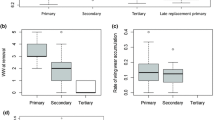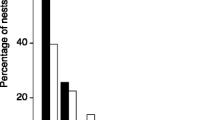Summary
We investigated the ontogeny of the social structure in relation to the reproductive success of its members in four colonies of the bumblebeeBombus terrestris L. In all four colonies, the time of colony development was divided into four periods. Only in the last period did worker-oviposition occur.
For analysing the social structure of the nests, we used the same methods as used earlier by v.Honk & Hogeweg (1981), in order to test their results, which were based on one colony only. Our results confirm theirs in:
-
1.
There exists a social hierarchy during all periods of colony development, in which the queen is always in the α-position.
-
2.
Dominance behaviour is positively correlated with activity (i.e. the number of interactions of a bee) in the nest.
-
3.
A number of the workers present in each period hold a position in the hierarchy close to the queen. These workers are called elite workers. They show a characteristic behavioural pattern, in which egg laying by the elite workers occurs in the last period of colony development.
However, contrary to their findings we observed:
-
1.
The proportion of elite workers varies from one period to another and from one colony to another, but is always less than 1/2 and generally decreases during colony development.
-
2.
The growth rate of our colonies is significantly larger.
-
3.
Only 33% of the workers which reach an elite position in one of the first periods, remain in such position through the last period. The dropping of the other 67% appears to be due to age and foraging: foragers quickly drop to a low position in the social hierarchy. Stability of the elite group is probably also related to the growth rate of the colonies.
-
4.
Workers which emerge more than three days after the onset of the last period (i.e. after the start of worker egg laying) have no more chance of becoming elite workers.
Not withstanding the extensive egg laying activity of the elite workers, their reproductive success is small; the queen eats most of the worker-laid eggs. Since, moreover, the queen starts to lay unfertilized eggs before the workers start to oviposit, she has the parentage of most of the males.
Some possible reasons, for the queen's ‘switch’ to the production of unfertilized eggs and for the start of worker egg laying are discussed.
Zusammenfassung
In 4 Kolonien der HummelartBombus terrestris L. wurde die Entstehung der sozialen Struktur und der Fortpflanzungserfolg von Königin und Arbeiterinnen untersucht. Die Entwicklung der Kolonien wurde in 4 Perioden unterteilt. Nur in der letzten Periode legten Arbeiterinnen Eier.
Für die Untersuchungen zur sozialstruktur, der Völker wurden die Methoden von v.Honk & Hogeweg (1981) verwendet, um ihre Ergebnisse, die an nur einem einzigen Volk erzielt wurden, zu überprüfen. Unsere Ergebnisse bestätigen folgendes:
-
1.
In allen Perioden existiert eine Dominanzhierarchie, an deren Spitze die Königin steht.
-
2.
Dominanzverhalten ist positiv mit der Aktivität im Nest (Anzahl der Interaktionen) korreliert.
-
3.
In jeder Periode nehmen einige Arbeiterinnen einen Rang in der Hierarchie nahe der Königin ein. Sie werden ‘Elite Arbeiterinnen’ genannt und sind durch spezifische Verhaltensweisen characterisiert. Arbeiterinnen, die dauernd der Elitegruppe angehören legen in der letzten Periode der Volksentwicklung Eier.
Im Gegensatz zu v.Honk & Hogeweg (1981) fanden wir jedoch:
-
1.
Der prozentuale Anteil dieser Arbeiterinnen kann in den einzelnen Kolonien und in den verschiedenen Perioden unterschiedlich sein; er ist aber immer kleiner als 1/2 und nimmt in der Regel während der Volksentwicklung ab.
-
2.
Die Wachstumsrate unserer Völker ist signifikant größer.
-
3.
Nur 33% derjenigen Arbeiterinnen, die während der ersten 3 Perioden die Elitegruppe erreichen, befinden sich auch noch am Ende der 4. Periode darin. Die restlichen Arbeiterinnen fallen in der Hierarchie, weil sie entweder zu alt sind oder zu sammeln beginnen; Sammlerinnen nehmen innerhalb kurzer Zeit einen niedrigen Rang ein. Die Stabilität der Elitegruppe hängt wahrscheinlich auch von der Wachstumsgeschwindigkeit des betreffenden Volkes ab.
-
4.
Arbeiterinnen, die erst in der 4. Periode schlüpfen, nachdem ältere Arbeiterinnen mit der Eiabage begonnen haben, können nicht mehr die Elitegruppe erreichen.
Obwohl Elite Arbeiterinnen häufig Eier legen, bleibt ihr Fortpflanzungserfolg gering; die Königin frißt alle Eier, die von Arbeiterinnen gelegt wurden. Sie beginnt mit der Ablage von Drohnen-Eiern bevor die Arbeiterinnen anfangen Eier zu legen, so daß die meisten Drohnen von ihr abstammen.
Mögliche Gründe für den Wechsel von der Ablage besamter zur Ablage unbesamter Eier der Königin sowie für den Beginn der Eiablage der Arbeiterinnen werden diskutiert.
Similar content being viewed by others
References
Alford D.V., 1975. —Bumblebees. Davis-Poynter, London.
Brian M.V., 1965. —Social insect populations. Academic Press, London and New York.
Cumber R.A., 1949. — The biology of humble-bees, with special reference to the production of the worker caste.Trans. R. Ent. Soc. London, 100, (1), 1–45.
Doorn A. van, Hogeweg P., 1985. — Die Entwicklung des agonistischen Verhaltens innerhalb der Arbeiterinnenkaste und zwischen Arbeiterinnen und der Königin während der Volksentwicklung ber der Erdhummel,Bombus terrestris.Mitt. dtsch. Ges. allg. angew. Ent., 4, (4–6), 328–331.
Free J.B., 1955. — The behaviour of egg-laying workers of bumblebee colonies.Br. J. Anim. Behav., 3, 147–153.
Free J.B., Weinberg I., Whiten A., 1969. — The egg-eating behaviour ofBombus lapidarius L.Behaviour, 35, 313–317.
Gower J.C., 1966. — Some distance properties of latent root and vector methods used in multivariate analysis.Biometrika, 23, 623–637.
Hamilton W.D., 1972. — Altruism and related phenomena, mainly in social insects.Ann. Rev. Ecol. Syst., 3, 193–232.
Hogeweg P., Hesper B., 1985. — Socioinformatic Processes: Mirror Modelling Methodology.J. Theor. Biol., 113, 311–330.
Honk C.G.J. van, Hogeweg P., 1981. — The ontogeny of the social structure in a captiveBombus terrestris colony.Behav. Ecol. Sociobiol., 9, 111–119.
Honk C.G.J. van, Röseler P.-F., Velthuis H.H.W., Hoogeveen J.C., 1981. — Factors influencing the egg laying behaviour in a captiveBombus terrestris colony.Behav. Ecol. Sociobiol., 9, 9–14.
Honk C.G.J. van, Velthuis H.H.W., Röseler P.-F., Malotaux M.E., 1981. — The mandibular glands ofBombus terrestris queens as a source of queen pheromones.Entomol. Exp. Appl., 28, 191–198.
Katayama E., 1971. — Observations on the brood development inBombus ignitus (Hymenoptera, Apidae), 1. egg-laying habits of queens and workers. Kontyû,39, (3), 189–203.
Katayama E., 1974. — Egg-laying habits and brood development inBombus hypocrita (Hymenoptera, Apidae), 1. egg-laying habits of queens and workers. Kontyû, 42, (4), 416–438.
Michener C.D., 1974. —The social behaviour of the bees. Harvard University Press, Cambridge, Massachusetts.
Owen R.E., Plowright R.C., 1982. — Worker-queen conflict and male parentage in bumble bees.Behav. Ecol. Sociobiol., 11, 91–99.
Pomeroy N., Plowright R.C., 1982. — The relation between worker numbers and the production of males and queens in theBombus perplexus.Can J. Zool., 60, 954–957.
Röseler P.-F., 1974. — Grössenpolymorphismus, Geschlechtsregulation und Stabilisierung der Kasten im Hummelvolk. In: Schmidt G.H., ed.,Sozialpolymorphismus bei Insekten.Wiss.Verlagsgesellschaft, Stuttgart, 298–335.
Röseler P.-F., Honk C.G.J. van, 1985. — Caste and reproduction in bumblebees. In:Engels W., ed.,Developmental physiology of social insects reproduction. Springer Berlin (in prep.).
Röseler P.-F., Röseler I., 1977. — Dominance in bumblebees. 8th Int. Congr. IUSSI, Wageningen, 232–235.
Röseler P.-F., Röseler I., 1984.—Der Einfluss von CO2 und der Kauterisation derPars intercerebralis auf die Aktivität derCorpora allata und die Eibildung bei Hummeln (Bombus hypnorum undBombus terrestris).Zool. Jb. Physiol., 88, 237–246.
Röseler P.-F., Röseler I., Honk C.G.J. van, 1981. — Evidence for inhibition of corpora allata activity in workers ofBombus terrestris by a pheromone from the queen's mandibular glands.Experentia, 37, 348–351.
Trivers R.L., Hare H., 1976. — Haplodiploidy and the evolution of the social insects.Science, 191, 249–263.
Ward J.H., 1963. — Hierarchical grouping to optimize an objective function.J. Am. Stat. Assoc., 58, 236–244.
Author information
Authors and Affiliations
Additional information
Supported by the Deutsche Forschungsgemeinschaft (Ro242/8-1&2).
Rights and permissions
About this article
Cite this article
van Doorn, A., Heringa, J. The ontogeny of a dominance hierarchy in colonies of the BumblebeeBombus terrestris (Hymenoptera, Apidae). Ins. Soc 33, 3–25 (1986). https://doi.org/10.1007/BF02224031
Received:
Accepted:
Issue Date:
DOI: https://doi.org/10.1007/BF02224031




